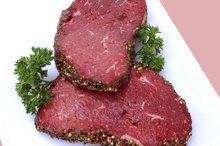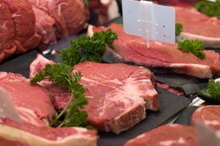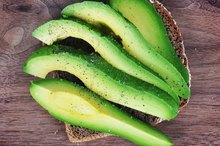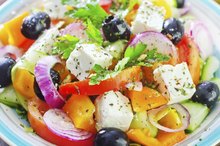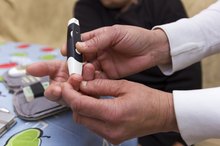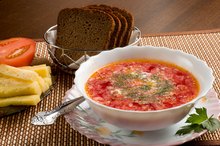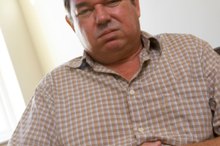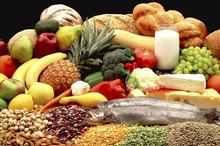Hemochromatosis Diet
Iron is an essential nutrient, but people with hemochromatosis accumulate an excessive amount of iron in their bodies. Despite eating the same foods as unaffected individuals, their intestines absorb more iron. The excess iron deposits in the liver, heart, pancreas and pituitary, potentially causing cirrhosis, liver cancer, diabetes and heart disease. Although increased iron absorption is to blame, a diet containing moderate amounts of iron is not discouraged.
Start With a Healthy Diet
In general, people with hemochromatosis should simply follow a heart-healthy diet. Clinical practice guidelines for hemochromatosis published by the American Association for the Study of Liver Diseases in 2011 state that there's no need to limit intake of naturally iron-rich foods. The guidelines further emphasize that withdrawing blood periodically -- therapeutic phlebotomy -- is more important for lowering iron levels than any particular diet.
What to Avoid
How Long Does Iron Stay in Your System?
Learn More
Clearly excessive iron intake should be avoided in people with hemochromatosis. Foods fortified with iron, including fortified breakfast cereals, nutrition bars and meal-supplement shakes, should not be consumed. Vitamin and mineral supplements containing iron should likewise be avoided. Although vitamin C can increase iron absorption, there's no need to avoid vitamin C-rich foods. However, vitamin C supplements should be avoided, according to the AASLD guidelines.
Guidelines from the European Association for the Study of the Liver published in 2010 also emphasize a generally normal diet, but avoiding iron-fortified foods and iron-containing vitamins. These guidelines note that alcohol increases liver damage and may increase iron absorption in hemochromatosis. Although they do not specifically recommend avoiding excessive alcohol, this would be prudent.
- Clearly excessive iron intake should be avoided in people with hemochromatosis.
- Guidelines from the European Association for the Study of the Liver published in 2010 also emphasize a generally normal diet, but avoiding iron-fortified foods and iron-containing vitamins.
Related Articles
References
- U.S. Department of Agriculture and U.S. Department of Health and Human Services: Dietary Guidelines for Americans, 2010
- Ems T, St Lucia K, Huecker MR. Biochemistry, iron absorption. In: StatPearls. Updated April 30, 2020.
- Barton JC, Edwards CQ. HFE hemochromatosis. In: GeneReviews. Updated December 6, 2018.
- National Institute of Diabetes and Digestive and Kidney Diseases. Eating, diet, and nutrition for hemochromatosis: What should I eat if I have hemochromatosis?. Updated January 2020.
- Heng SP, Letchumanan V, Deng CY, et al. Vibrio vulnificus: An environmental and clinical burden. Front Microbiol. 2017;8:997. doi:10.3389/fmicb.2017.00997
- Lönnerdal B. Calcium and iron absorption-mechanisms and public health relevance. Int J Vitam Nutr Res. 2010;80(4-5):293-9. doi:10.1024/0300-9831/a000036
- Kobayashi Y, Wakasugi E, Yasui R, Kuwahata M, Kido Y. Egg yolk protein delays recovery while ovalbumin is useful in recovery from iron deficiency anemia. Nutrients. 2015;7(6):4792-803. doi:10.3390/nu7064792
- Pawlak R, Berger J, Hines I. Iron status of vegetarian adults: A review of literature. Am J Lifestyle Med. 2018;12(6):486-98. doi:10.1177/1559827616682933
- Armah SM, Boy E, Chen D, Candal P, Reddy MB. Regular Consumption of a igh-phytate diet reduces the inhibitory effect of phytate on nonheme-iron absorption in women with suboptimal iron stores. J Nutr. 2015;145(8):1735-9. doi:10.3945/jn.114.209957
- Ma Q, Kim EY, Lindsay EA, Han O. Bioactive dietary polyphenols inhibit heme iron absorption in a dose-dependent manner in human intestinal Caco-2 cells. J Food Sci. 2011;76(5):H143-50. doi:10.1111/j.1750-3841.2011.02184.x
- Delimont NM, Haub MD, Lindshield BL. The impact of tannin consumption on iron bioavailability and status: A narrative review. Curr Dev Nutr. 2017;1(2):1-12. doi:10.3945/cdn.116.000042
- Lane DJ, Jansson PJ, Richardson DR. Bonnie and Clyde: Vitamin C and iron are partners in crime in iron deficiency anaemia and its potential role in the elderly. Aging (Albany NY). 2016;8(5):1150-2. doi:10.18632/aging.100966
- Grochowski C, Blicharska E, Baj J, et al. Serum iron, magnesium, copper, and manganese levels in alcoholism: A systematic review. Molecules. 2019;24(7);1361. doi:10.3390/molecules24071361
- Christides T, Sharp P. Sugars increase non-heme iron bioavailability in human epithelial intestinal and liver cells. PLoS ONE. 2013;8(12):e83031. doi:10.1371/journal.pone.0083031
- Singh A, Bains K, Kaur H. Relationship of dietary factors with dialyzable iron and in vitro iron bioavailability in the meals of farm women. J Food Sci Technol. 2016;53(4):2001-8. doi:10.1007/s13197-015-2153-0
- Alves C, Saleh A, Alaofè H. Iron-containing cookware for the reduction of iron deficiency anemia among children and females of reproductive age in low- and middle-income countries: A systematic review. PLoS ONE. 2019;14(9):e0221094. doi:10.1371/journal.pone.0221094
Writer Bio
Jill Corleone is a registered dietitian and health coach who has been writing and lecturing on diet and health for more than 15 years. Her work has been featured on the Huffington Post, Diabetes Self-Management and in the book "Noninvasive Mechanical Ventilation," edited by John R. Bach, M.D. Corleone holds a Bachelor of Science in nutrition.
